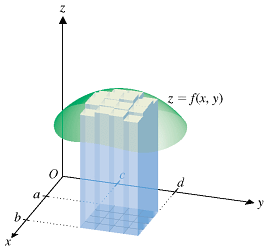Finding Extrema of Multivariable Functions
Method for Finding Extrema
In a region
Next, you must check the boundary. So, you can either use Lagrange multipliers $f(x,y) = \lambda{}g(x,y)$, or you can just plug it in. Take this question for example $$f(x,y) = x^2 + 4y^2 - x + 2y \text{ , and the boundary is } x^2 + 4y^2 = 1.$$ On the boundary, this becomes $f(x) = (x^2 + 4y^2) - x \pm \sqrt{1 - x^2} = 1 - x \pm \sqrt{1 - x^2}$. Now, you need to find a critical point of that, so you take the derivative. $$f'(x) = 0 = -1 \pm \dfrac{-x}{\sqrt{1- x^2}} \rightarrow x = \pm \frac{\sqrt{2}}{2}$$ So, after doing this, you compile a list of possible absolute maxima on that region. You can just plug in the points and find the largest and smallest values.
No Boundary
Without a boundary, you can only find local maxima, so you can't just plug in all the points and find the largest ones.
David Witten

